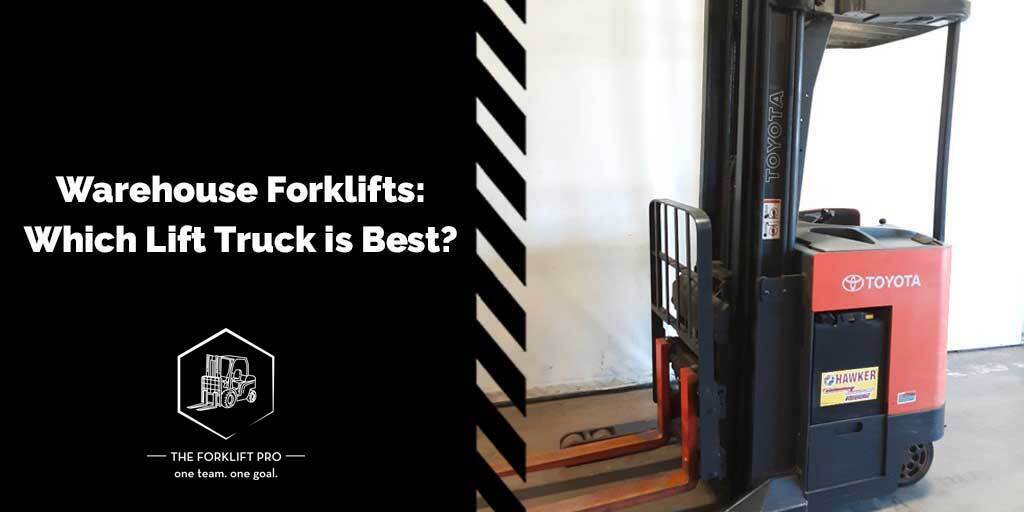One of the most common types of equipment found in industrial warehouses is the forklift. This useful piece of heavy machinery has a wide range of applications – like raising, lowering, stacking, organizing, pushing, pulling, and tiering pallets, crates, and other materials. They allow workers to move equipment efficiently and quickly. It’s important, when investing in a warehouse forklift, to know what your options are. Keep reading for tips and equipment information.
What are Warehouse Forklifts?
A warehouse forklift is what most people think of when they hear the word ‘forklift.’ Load capacities for warehouse forklifts are generally designed to handle an average of 5,000 lbs. Warehouse forklifts created for heavier applications can handle up to 20,000 pounds.
New Versus Used Lift Trucks
It might be tempting to purchase a shiny new forklift or fleet of forklifts for your warehouse, but that won’t always help you get the most bang for your buck. In fact, buying used MHE is the smarter move!
There are many benefits to buying used forklifts.
- Used forklifts are more dependable and are less likely to break down.
- They are less expensive than brand-new lift trucks.
- The attachments, accessories, and spare parts you might need are less expensive, too.
- Your business can take a Section 179 tax deduction on your purchase.
Before you buy, make sure you are purchasing from a reputable wholesale forklift dealer, like The Pros. We put all of our forklifts through a rigorous inspection and servicing process before listing them in our inventory. Not only do we stand by the reliability of each used forklift we sell, but we also have first-hand experience with the equipment so we can provide you with its history and suggest how it can best be used in your warehouse.
Now that you know you’re in the right place to purchase quality, used material handling equipment, we can talk about how to choose the right piece of machinery for use in your warehouse.
Need to clear your books before you buy? We will take your used MHE off your hands!
How to Choose a Warehouse Forklift
Is your warehouse in need of forklift help? There are several different forklift types, or classifications, depending on the specific needs of the business. If you’re looking for the best warehouse forklift for your business, The Forklift Pro has a few tips to help.
Warehouse Fork Lift Classifications
There are seven classifications for forklifts, with the first three classes being mainly designed for indoor, warehouse use.
Class I – Electric Motor Ride Truck: these electric forklifts are used in indoor settings where air quality is a concern, like a small, enclosed warehouse.
Class II – Electric Motor Narrow Aisle Truck: the ideal warehouse forklift, this classification of truck is powered by a battery and is ideal for Moving inventory in narrow or tight spaces.
Class III – Electric Motor Hand Truck: also powered by battery, a Class III forklift is designed for Quickly loading up delivery trucks across short distances.
Best Lift Truck Type for Warehouses
Among these different classifications are the different warehouse forklift types: counterbalance forklift, side loader, reach truck, order picker, and pallet jack.
Counterbalance Forklift
One of the most common warehouse forklifts is the counterbalance forklift. They have forks in the front and a weight in the back of the vehicle to counterbalance the weight of the load. There are different types of counterbalance forklifts, including stand-up and 3-wheel.
Side Loader
Typically found in manufacturing facilities, side loaders are built to handle bulky and heavy items. Operators stand in a sideways compartment, loading the truck alongside the shelves and racks without having to turn. Side loaders are ideal for navigating narrow aisles.
Reach Truck
Reach trucks are utilized in warehouses because of their ability to extend to extreme heights. Some models of reach trucks can reach up to 20 feet high and lift loads up to 12,000 pounds.
Order Picker
As opposed to most forklifts being designed to lift materials, order pickers are mainly designed to lift operators up to warehouse racks and carry individual units. Since they can pick one or two units rather than bringing down full pallets and loads, they are intended for customer order warehouses and storage facilities.
Pallet Jack
Pallet jacks can be manual or electric. They are used to lift pallets of materials off of the ground to move in and out of trucks to warehouses. Electric-powered pallet jacks are generally moved forward or backward by a throttle on the handle and steered by swinging the handle in the desired direction.
Get Help from the Experts at The Forklift Pro
While seemingly overwhelming at first, these differences ultimately help consumers determine which is the best for their needs individually. Our pros are knowledgeable and ready to answer the questions you have about warehouse forklifts and so much more. So, if you need help selecting the right type of forklift for your warehouse, contact The Forklift Pro today.

